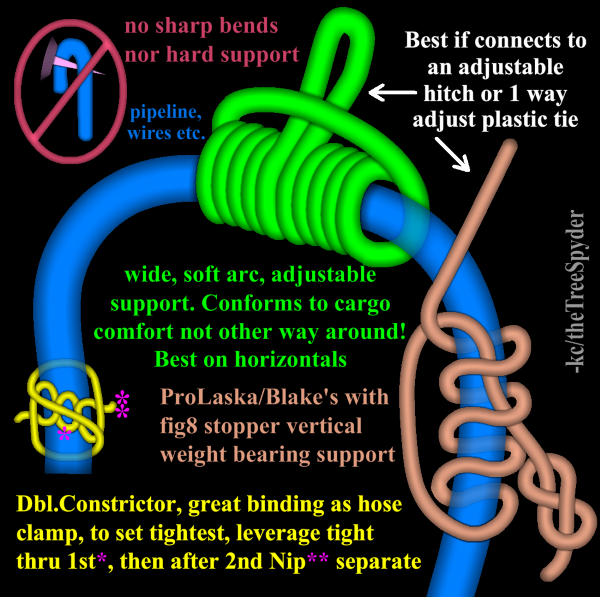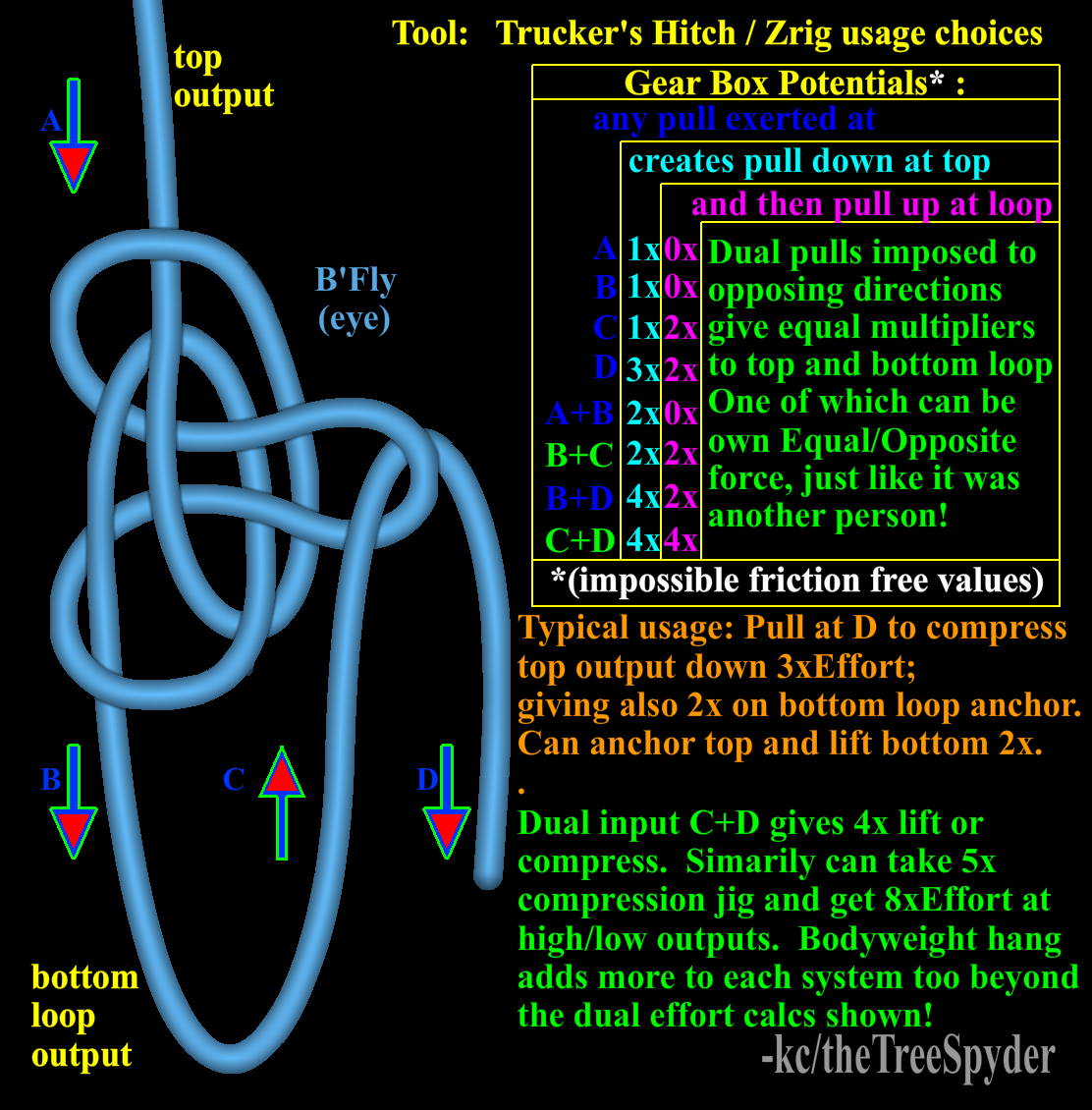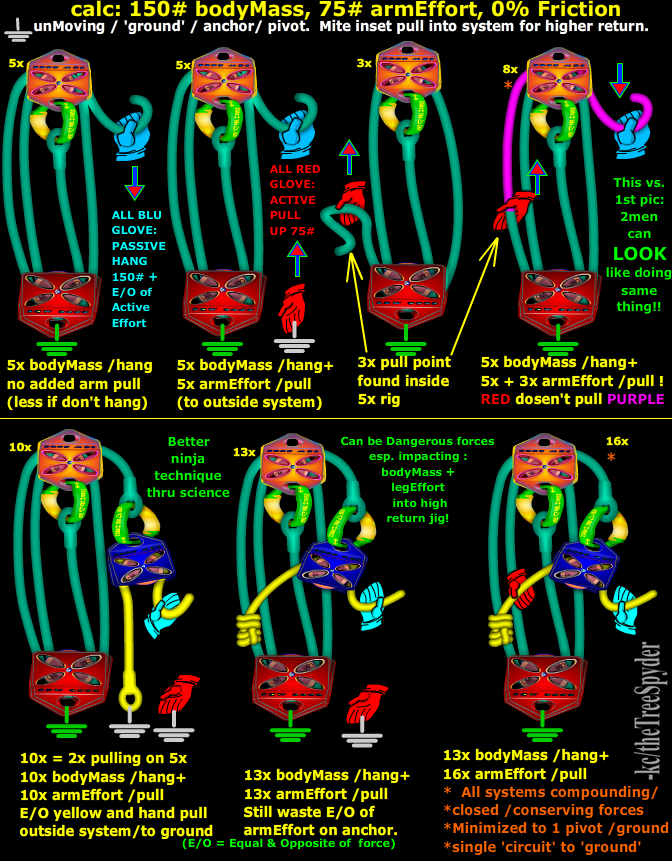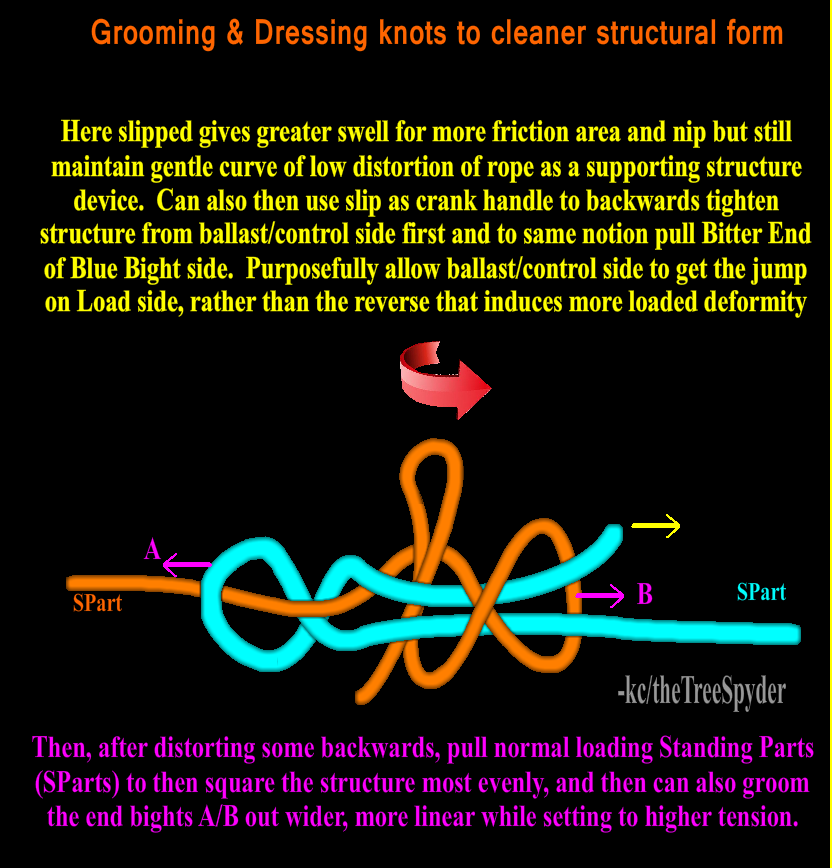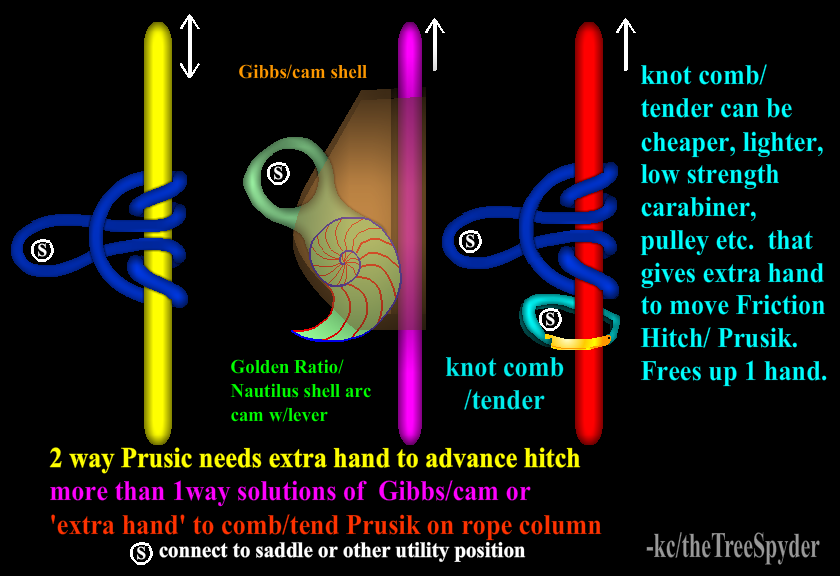theTreeSpyder
TreeHouser
- Joined
- Feb 12, 2016
- Messages
- 691
- Thread Starter Thread Starter
- #201
Another fine point, just tossed out there a few times as woven thru the ABoK lessons, w/o much focus given:
from lesson#1669: "...a Round Turn on the Standing Part adds materially to the strength of the knot."
>>knudeNoggin experiments and states not if Round Turn(RT) pre-fixes on the host mount
>>i think RT on host takes enough tension out that RT on Standing Part(SPart) can't grab hard enough to give the effect
>>than a simpler Half Hitch(HH) that just shears across the SPart (as sole load support) most harshly
>>perhaps carrying some of the load force/unloading SPart some
(if enough tension left in that part of rope for RT to use to grip/only 1 pre-fixing Turn).

.
Standard Half Hitch ((HH) shears across the Standing Part more, this does grip harder on the host than if the Round Turn (RT) is used .

>>this would pull open even more on load side of host , at the already worst Nip position of standard HH.
>>so for #1669, Ashley uses purposefully the fig8 rather than HH tuck style, and gives 2 tucks.
This makes stronger than previous Timber Hitch fig8, that he shows can take 2 instead of 1 tuck
>>as recommends 3 tucks for normal Timber Hitch
>>but that was in higher friction Hemp >> would go with 3+ tucks always and all ways
Would never just tightly pack the 3 tucks close to Standing Part, but rather spread out so last tuck is in highest Nip region logical
>>and preceding Nips are much less consequential helpers, more of spacers to the better Nip.
.
Round Turn pulling along the sole load support of the SPart more properly, rather than shearing across SPart so harshly (in any mechanix, cutting across 90 degrees is very harsh)
See how these pull more along, inline the long axis of rope, like a splice does more properly.
rather than shearing across supporting column architecture at right angle like do with a wrench to break, not support something.

.
In round slings modeling we commonly see these forms of this principle.

See Cat's Paw as Double Bearing on host, 2 support legs, each with loose splice hold
>>VERY strong compared to most any other knot
>>can have Girth version, but not self adjusting legs
>>logically can have Cow version, of 1 support leg
or reduce back to fig8.RT version maintaining same concept.
.
The separate parts shown in original picture can be seen in and taken to other knots.
>>just as if rope was another material
>>just as if were working in wood, rock or metal etc. and take out one part and out in a 2 hole version to hold rather than 1
Rope is just another material, subject to same support rules as other materials
Save the exclusions of defining differences of the 'flexibles class'
>>don't have to heat, pound, chip, carve to re-form >> just unload
>>don't need connectors between parts and utility functions as is already built in!
But, can only be rigid when
A>loaded
B>along linear length
C>in tension direction(along linear length)
from lesson#1669: "...a Round Turn on the Standing Part adds materially to the strength of the knot."
>>knudeNoggin experiments and states not if Round Turn(RT) pre-fixes on the host mount
>>i think RT on host takes enough tension out that RT on Standing Part(SPart) can't grab hard enough to give the effect
>>than a simpler Half Hitch(HH) that just shears across the SPart (as sole load support) most harshly
>>perhaps carrying some of the load force/unloading SPart some
(if enough tension left in that part of rope for RT to use to grip/only 1 pre-fixing Turn).

.
Standard Half Hitch ((HH) shears across the Standing Part more, this does grip harder on the host than if the Round Turn (RT) is used .

>>this would pull open even more on load side of host , at the already worst Nip position of standard HH.
>>so for #1669, Ashley uses purposefully the fig8 rather than HH tuck style, and gives 2 tucks.
This makes stronger than previous Timber Hitch fig8, that he shows can take 2 instead of 1 tuck
>>as recommends 3 tucks for normal Timber Hitch
>>but that was in higher friction Hemp >> would go with 3+ tucks always and all ways
Would never just tightly pack the 3 tucks close to Standing Part, but rather spread out so last tuck is in highest Nip region logical
>>and preceding Nips are much less consequential helpers, more of spacers to the better Nip.
.
Round Turn pulling along the sole load support of the SPart more properly, rather than shearing across SPart so harshly (in any mechanix, cutting across 90 degrees is very harsh)
See how these pull more along, inline the long axis of rope, like a splice does more properly.
rather than shearing across supporting column architecture at right angle like do with a wrench to break, not support something.

.
In round slings modeling we commonly see these forms of this principle.

See Cat's Paw as Double Bearing on host, 2 support legs, each with loose splice hold
>>VERY strong compared to most any other knot
>>can have Girth version, but not self adjusting legs
>>logically can have Cow version, of 1 support leg
or reduce back to fig8.RT version maintaining same concept.
.
The separate parts shown in original picture can be seen in and taken to other knots.
>>just as if rope was another material
>>just as if were working in wood, rock or metal etc. and take out one part and out in a 2 hole version to hold rather than 1
Rope is just another material, subject to same support rules as other materials
Save the exclusions of defining differences of the 'flexibles class'
>>don't have to heat, pound, chip, carve to re-form >> just unload
>>don't need connectors between parts and utility functions as is already built in!
But, can only be rigid when
A>loaded
B>along linear length
C>in tension direction(along linear length)



